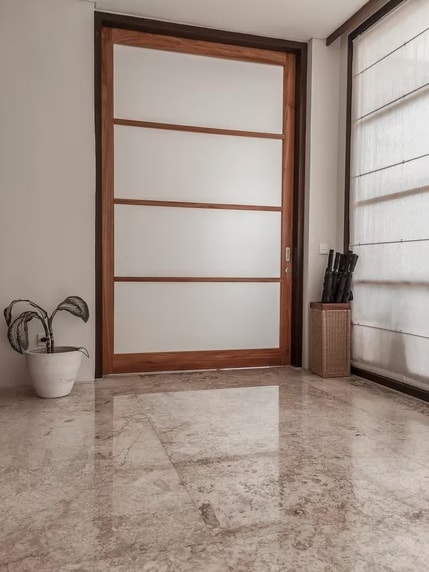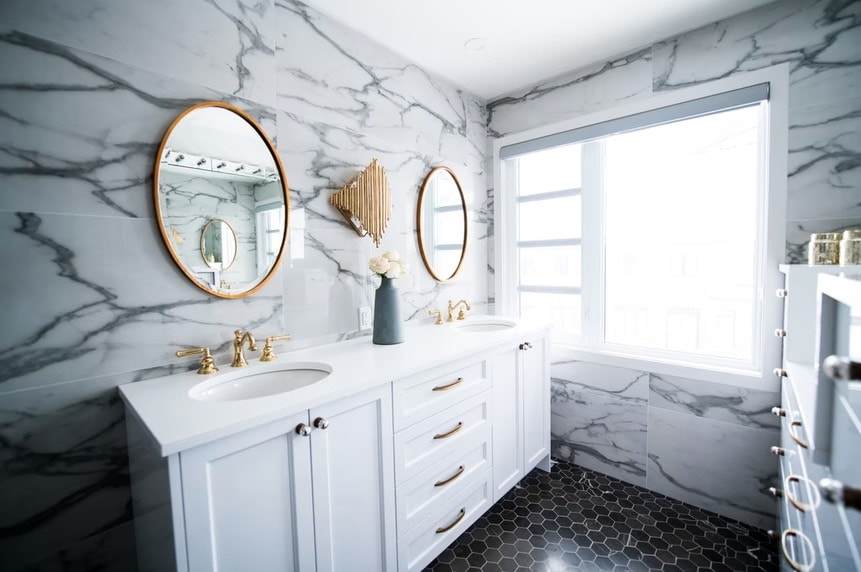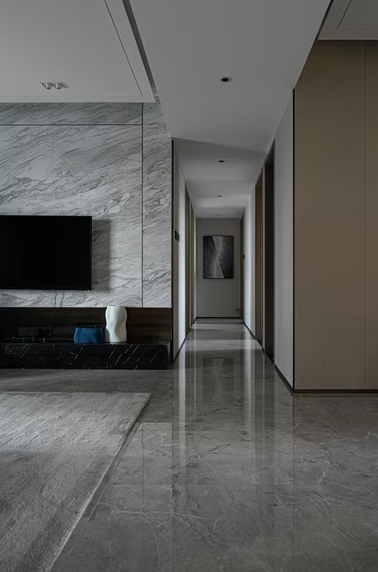Marble has been a popular building material since before the Ancient Grecian times when marble was first used in construction. Still, in 2020, marble is prized for its elegance and classic style. While it may have been the material of choice for kings and queens, it now can be incorporated into any household. For example, it can be used as countertops, wall tiles, and flooring.
Stone flooring adds natural beauty to your space while giving it a smooth, clean finish. Marble is a traditional stone-flooring option known for its elegant look. However, despite its beauty, marble flooring does come with some potential drawbacks to consider. Comparing the marble tile pros and cons can help you decide if it’s the best option for your flooring project.
While we look at multiple options for the floors of our homes, none of us can deny the natural grace of the old favourite, marble. This stone comes with unique vein patterns that add a luxurious and opulent feel to your interiors. Traditionally associated with royalty, marble flooring still carries hints of wealth and elegance. So if you want to choose the ground beneath your feet to add a plush feel to your interiors, consider using this stone in your home.
There’s nothing more elegant than marble floors. With its glossy exterior and veining design, it adds a sense of royalty to an ordinary house.
However, cleaning marble isn’t as straightforward as other floor types. Marble is highly porous and can damage quickly if not handled with care.
How Are Marble Floors Made?

Marble has been used throughout time for various purposes. It was most commonly used to create sculptures in ancient Greece due to the softness made it easier to carve. Nowadays, though, it’s used in commercial and residential buildings. It’s available in various colours, including pink, red, black, and more.
Marble is a metamorphic rock, typically formed from limestone or other sedimentary carbonate rocks. The heating process causes the recrystallization of the primary mineral grains within the marble. Marble rock is, therefore, made up of an interlocking mosaic pattern of carbonate crystals.
Maintenance and Repair
Once installed, routine maintenance of a marble tile floor is relatively easy; it requires the same kind of sweeping and damp mopping you would do with a ceramic tile floor. However, marble is fairly porous, unlike ceramic tile, so you shouldn’t allow water to puddle and stand on the surface. In addition, standing water can penetrate the stone and discolour it.
Marble has a pH on the base (alkaline) side due to its origin as a sedimentary limestone. This means that it can have a chemical reaction whenever it comes in contact with acidic substances.2 This can include a wide variety of foods, sauces, beverages, and cleaning products. Unfortunately, the discolouration stains that come from these materials are usually permanent. This can be prevented by applying a penetrating chemical sealer and a surface sealer after installation. But for optimal protection, the surface sealer needs to be reapplied annually.
Routine maintenance is pretty simple. First, sweep and use a damp mop, similar to ceramic tile flooring. However, be careful to use cleaners that are safe for marbles. Use a cleanser that is not too acidic, not too alkaline. We find Mr Clean usually does the trick or experiment with your favourite organic cleaner. Next, you will need to reseal your stone periodically. This is not difficult to do. If water does not lay on the surface of the stone like a newly waxed car, it’s time to reseal. The extra care is worth the spectacular beauty that you will have in your home.
Even though it is stone, marble is a relatively soft material that can be scratched, scraped, and chipped under the wrong conditions. This is especially true if the material is polished, as the imperfections will be more noticeable in the smooth, flat solid surface. Unfortunately, scratches cannot be easily repaired without replacing the damaged material entirely.
Removing Dust and Dirt
Regularly sweeping your marble floors is an excellent way to keep them looking clean. However, you have to be careful with the tools you’re using.
We highly recommend investing in a dust mop or dry mop. These are easy to use and consist of a long handle with a microfiber cloth at the end. The microfiber attracts and collects dirt, dust and hair effectively while being gentle on the surface.
You can also use a flared broom for daily sweeps. Flared brushes are softer compared to unflared brooms. The ends of the bristles resemble split-ends and pick up dust efficiently.
The porous marble is commonly considered difficult to maintain, but think again before you accept this as fact! This flooring is indeed susceptible to stains, even from tea, coffee and fruit juices. But you can still have pristine floors!
- Regular cleaning: Use a soft cloth or a mop to clean your floors regularly. Choose mild cleaning products and steer clear of acids and alkaline products that could damage this stone. Instead, a mild product will keep your floor in top shape for a long time.
- Cleaning up spills: In case of a liquid spill, clean the stain as soon as possible to prevent it from leaving a lasting mark. If not, sprinkle baking soda on your marble surface and wipe it away with a clean, damp cloth. Be careful not to leave scratch marks. Also, ensure that you wipe away all the baking soda!
- Sealing the floors: If you want to protect your floors from stains, consider using a floor sealant. This forms a protective layer over the natural stone and prevents a direct exposure to potentially harmful solvents. If you plan to have marble floors in your kitchen or bathroom, then a sealant becomes necessary to avoid the seepage of water.
- Polishing: This enhances the natural glow of marble while simultaneously reducing its absorbency. So go ahead and polish your floors to make them easier to maintain. However, this process also causes the thinning of marble, so ensure that you let the right amount of time pass before repeating this process.
Marble flooring requires daily cleaning, prompt attention to spills, and regular sealing.
While marble is a durable flooring, it requires a little extra care to help it retain its beauty.
- Sweep marble floors daily to remove tracked-in sand or grit. Walking over sand particles can lead to scratches on a marble floor.
- Wipe up spills promptly. Acidic liquids, such as orange juice or vinegar, can stain the marble. Water won’t stain marble, but over time can dull its surface.
- Seal polished marble floors with a good stone sealant, such as Miracle Sealants’ 1-Step Natural Stone Sealer and Color Enhancer, at least once a year. Honed marble is more porous than polished marble, and it’s a good idea to seal a honed marble floor twice per year to help it resist staining.
- Use a mild, non-acidic floor cleaner for regular mopping. The product should specify its suitability for marble floors on the label. Alternately, make your own gentle floor cleaning solution by combining ½ cup of ammonia and 1 tablespoon of dish soap in a gallon of water.
Frequently Asked Questions About Marble Floors
Is marble better than tiles?
It is used in high traffic areas. It has a smooth and glazed finish which gives luminous shine. It is scratch-resistant and fire-resistant. It is very easy to clean marble flooring.
Is marble a good choice for the kitchen floor?
Marble is one of the best natural stone types, which you can use in your kitchen. It can be bought as floor tiles, wall tiles, and countertop slabs, which makes the application of marble all around the kitchen very easy.
Do marble floors increase home value?
Home improvements made with natural stone will always add value to residential properties, and marble has always been considered one of the best stones for homeowners seeking to boost their investments’ value.
Marble Floors: DO’s and DON’Ts
Marble flooring is a great investment for any home. And although marble is hard as a rock, its smooth surface can be easily damaged if the proper precautions are not taken. So here are some “do’s”, “do’s”, and recommended care for your marble flooring.
DO’s
Sand and grit carried in from outdoors by shoes can easily scratch and grind your marble floor’s surface like sandpaper. To prevent dirt, water, and road salts from getting to your marble floors, you should place large mats with waterproof backings at all entrances to your home (helpful accessory: doormats with waterproof backings). In particular, you will want to catch road salt, which can dissolve and pit your marble’s surface.
It would help if you also protect your marble floor by placing rugs in areas of high traffic. And furniture legs that come in contact with the marble floors should be fitted with special felt pads or plastic floor protectors. And any houseplants should be placed on a special base or stand to prevent deep stains and scratches (helpful accessory: plant mats).
And if any liquids are spilled on your marble floors, quickly remove the spill by blotting with a paper towel (helpful accessory: plastic floor protectors). But do not wipe since wiping will spread the spill.
DON’Ts
Marble floor tiles are porous and can easily be discoloured by spills from food, oil, ink, water damage, etc. Don’t allow any liquids or foods containing acid to be spilled onto your marble floors. These can etch or leave dull marks on marble surfaces. Examples of acidic liquids are lemon juice, orange juice, carbonated beverages, cranberry juice, apple juice, wine, tomato, etc.
The use of detergents for routine cleaning is not recommended as they tend to dull polished stone, and many contain chemicals that are harmful to your marble’s finish. For example, cleaning detergents that contain acid can cause etch marks and stains on your marble. Examples of these are tile cleaners, vinegar, Ajax, Soft Scrub, etc. And cleaning solutions that contain high alkaline levels or bleach can also damage marble floors and cause them to lose their shine.

Avoid dragging heavy objects or leaving sharp items on the floor, as these can cause deep scratches or gouges that are permanent. And do not allow your marble to come in contact with materials that can stain the surface, such as items made of iron, bronze, copper, oil and grease, ink, tobacco, and smoke.
Tap water can also damage a marble floor. Local water could contain chlorine, salts, magnesium, potassium and other minerals. When water is used regularly to clean a marble floor, it may ruin certain types of marble by causing pitting, spalling and yellowing.
And never attempt to remove stains or deposits by scraping, scouring, or indiscriminately applying bleaching agents, liquid marble cleaners, or other harsh chemicals.
Recommended Care
Always use the gentlest means possible to clean your marble floor. You should routinely clean your marble floor of superficial dirt by using a minimum amount of plain warm water and a cotton string mop (but remember the problems with using regular tap water that we described above). And be sure only to use neutral cleaners or stone soap liquid specifically designed for natural stone that will not harm the surface or erode its lustre (helpful accessory: marble floor cleaners).
Damp-mop the floor regularly to remove dirt and soil. Frequent mopping will help prevent soil from penetrating the surface. Use only cold or warm water that is clean. Do not use hot water since this will cause the marble floor tile to streak.
Add a very small amount of ammonia to water (so little that you can’t even smell it). Alternatively, you can use extremely dilute solutions of a mild, neutral pH detergent such as dishwashing liquid. But first, be sure to test it on a small marble area that is in the least noticeable area.
If your marble tends to streak when you mop the floor, try drying the marble with a clean terry cloth towel or buffing with a residential buffing machine.
And finally, if your marble floor is scratched, deeply soiled, or has a build-up of yellowed wax or discoloured sealers. Again, a professional can restore the lustre and natural colour by wet sanding and chemical stripping.
- Ammonia.
- Ceramic floor cleaners.
Tips for Maintaining Marble Floor and Avoiding Damage
Clean Spills as They Happen
Due to the porous surface, marble will absorb standing water and liquids — including spills and stains. When this happens, your marble will either stain or discolour.
The best thing to do is to clean spills as they happen. Use a damp cloth (preferably microfiber) to blot up the spill. Start from the edges and work your way into the centre to avoid spreading the liquids.
Never Allow the Floor to Air Dry
Allowing your marble floors to air dry can be fatal. When the floor air dries, both water and detergent are getting absorbed by the marble. This will discolour or stain your floors.
Always use a clean cloth or towel to dry the floor after mopping. It’s also a good idea to use as little water as possible when washing by wringing it thoroughly.
The other process of rinsing and drying marble floors can make cleaning more difficult. However, this will give the best results while preserving the sensitive surface.
Go for Mild Detergents
If you choose to use a detergent on your floors, always select a pH-neutral product. These pH-neutral cleaning products are gentle to the surface thus it is safe to use on marble. However, they’re less efficient at removing tough stains compared to acidic and alkaline products.
Vinegar is commonly used to clean various types of flooring, such as tiles and hardwood. However, this is a big no-no when it comes to marble. Vinegar is acidic, with a two or three pH level, and will, therefore, damage the surface.
Felt Removes Scuff Marks
Scuff marks can happen when furniture is dragged along the floor — sneakers or other shoes could also cause them. Whatever the cause, though, scuff marks can be frustrating to discover on your beautiful marble floors.
Most scuff marks should be able to come off when you mop. However, if you notice a few stubborn marks, you can use a felt pad or tennis ball. Lightly apply some mild detergent and water to the pad and rub the floor along the grain.
Avoid rubbing in circular motions as this can damage the marble floors.
Use a Marble Sealer
Sealing your marble floors is the best way to preserve them. It’s a job easily done for any creative DIY’er. You can buy marble sealers at your local supply store or home improvement store. There’s also a range of choices on Amazon and Home Depot.
Use a product such as this spray from Black Diamond. It’s easy to use and will protect your marble against spills and grease.
With most sealers, you apply it generously and allow the product to penetrate the natural stone. Then, after the required time, you either wipe off or clean off the excess.
Some sealers require resealing every three years, while others will last five. If you’re unsure how to seal your floors, contact a professional to help you out.
Sweep Regularly, Mop Occasionally
Dust can quickly make your marble floors look dull. In addition, dirt with large grains can cause scratches on your floors if dragged around by shoes or bare feet.
Sweeping regularly using a soft broom or dust mop can keep dust, dirt and scratches at bay. Light vacuuming with an appropriate machine can also do the job.
You might be pleased to hear that marble floors don’t require mopping that often. Unless you have a particularly busy home with pets and children, once a month should suffice a deep clean. Because marble is so sensitive to water, limiting mopping can help preserve your floors’ delicate surface.
Use Baking Soda with Caution
If you encounter very stubborn stains, you may use baking soda — but with caution. Baking soda is alkaline and should be handled with care. It’s also labelled as a mild-abrasive cleaner, so there’s no need to use too much force when cleaning.
Sprinkle a small amount of baking soda on the stain. Use a soft, damp cloth to rub the surface gently; do not scrub. Instead, rinse the area well using cold water to neutralize the alkaline, and dry the spot using a soft towel.
Make sure you don’t leave the baking soda on the floor for too long. It’s always better to repeat a process rather than risk prolonged exposure. Also, baking soda will dull the glossy finish on marble floors.
Use Carpets and Rugs
Placing a few carpets or rugs in high traffic areas can help to prevent wear on the floors. It will also limit dust and dirt.
You can also use doormats by entrances as a friendly reminder for visitors to wipe their shoes or remove them.
Using colourful rugs and carpets is an excellent way to show off your style and taste. Mix and match different colours and patterns to create a pleasant atmosphere for you and your family. They’ll also keep your feet warm in winter — marble can get cold.
Marble floors are highly durable, and most homeowners do not need to change them throughout their lives. Moreover, the stone is heat-proof; hence it is always cool to the feet, a blessing in a warm country like Singapore. Further, if you plan to sell your house, the floor can amp up the home’s value.
No flooring material conveys elegance better than marble, but marble is a temperamental stone that requires considerable care when installing it and when caring for it afterwards. So be aware of its limitations before you spend the money on marble flooring.
